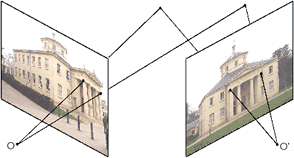| enginuity |
|
home | contents | previous | next |
From a different perspective
Artists such as Masaccio have used the concept of vanishing points since the early fifteenth century to produce a sense of perspective in their paintings. These paintings were produced with such accuracy, that it is now possible to invert the projection process and 'walk in' to them, using technology produced by researchers in Roberto Cipolla's group.
A software package known as 'PhotoBuilder' has been produced which can be used to build 3D models from two or more ordinary photographs allowing the viewer to ‘walk in' to works of art or take a virtual tour around an historic building. The software makes use of information about the parallel and perpendicular lines from the photographs, which must contain some overlapping feature. Unlike photogrametric methods, the system uses uncalibrated cameras, automatic feature detection, tracking and matching. The vanishing points can then be calculated and thus 3D information displayed.

It is envisaged that this software will be of particular use to architects who wish to provide their clients with the possibility of examining their buildings in photo realistic settings remotely from many different angles. Take a turn around some of the famous buildings in Cambridge on our website where you will find other examples of research from this group. Try this out on your own home by downloading the package for free!
From Sculpture to e-commerce
As more of us turn to the internet for our day to day shopping, the possibility of viewing products from every conceivable angle is to be welcomed. Research being carried out in Cipolla’s group will allow this by enabling the automatic reconstruction of curved surfaces.
This is a more challenging problem than that of recovering information from the rules of linear perspective. Information about curved surfaces must be derived from their profiles or silhouettes. For instance, when we view a sculpture, it is common to walk around it and view it from many different angles to obtain visual information about its shape. Researchers in the Computer Vision group have developed a system for obtaining such information automatically with cameras, in such a way that neither camera or image has to be calibrated.
An object can be rotated in front of a fixed camera, and its outline or contour can then be recorded. The contours extracted are represented by 'B splines' which are tracked and reconstructed to produce an approximate model.
There is a lot of interest in this process from the games and graphics industry, as it will be possible to create a three dimensional image of the person playing a game, enabling that image to be used in the game. A full demonstration of the technique can be found on Roberto’s web site.
| number 9, July 2000 | home | contents | previous | next |